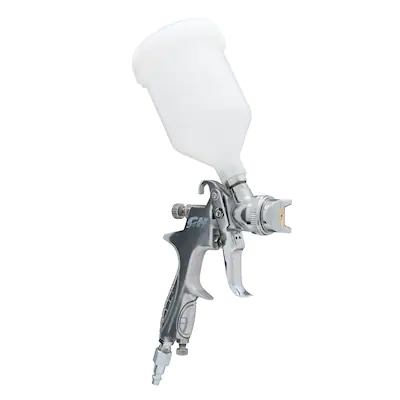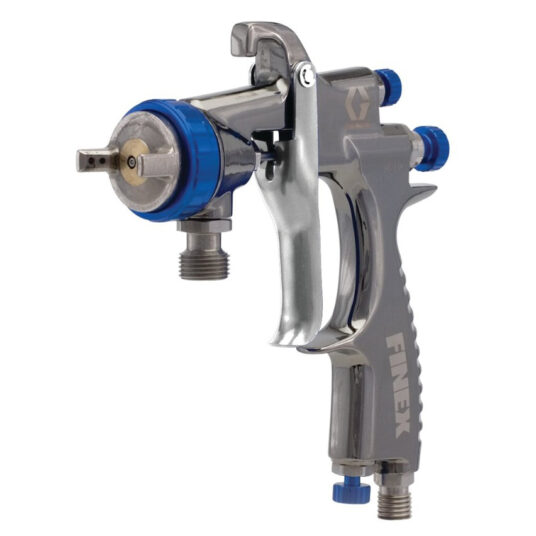Whether you are a professional painter or an amateur painter, a paint sprayer can save you a lot of time. The only drawback is that they require a lot of preparation and attention, so it is important to know what to do before using one.
Table Content:
1. Preparation
2. Cup-style pneumatic sprayers
3. HVLP pressure fed spray guns
4. Drawbacks of airless sprayers
- Preparation
Whether you’re a novice sprayer or a veteran, there are several precautions to take before you use a paint sprayer. Some precautions involve wearing protective equipment, laying out your equipment, and staying vigilant.
- You should also prepare
your sprayer by cleaning it. It’s also a good idea to check for oversprays. You should also use a paint funnel to prevent spills.
- Another trick is to mix the paint
in several containers. This will ensure that you get an even color throughout your project. You should also wear a mask and respirator.
When you are ready to use the sprayer, set it up in a central location. Make sure you leave a little room around the sprayer.
It’s also a good idea to sand the surface. This will prepare it for the paint and allow the primer to stick better. You may also wish to use a putty knife to smooth the surface out.
Make sure you do a test run on a scrap piece of plywood. You’ll need to check the quality of the paint you’re using.
The spraying process can be tricky at first. Using a Graco Pressure Roller Kit or other similar device can help.use the most appropriate tips. You’ll want to set up your sprayer in a way that is appropriate for your project. It should be positioned six to eight inches from the wall. You should also use a hat and safety glasses.
You should also practice on a cardboard box to get a feel for the proper technique. You should also wear protective gear including a helmet, mask, and a spray sock.
- The best way to use
a paint sprayer is to apply it to a clean, dry surface. It’s also a good idea for you to be aware of any appliances that are in close proximity to your spraying area.
When you are finished, you’ll need to clean your sprayer and reattach any fixtures you’ve removed.
2. Cup-style pneumatic sprayers

- Depending on your needs
you can choose from a range of different types of paint sprayers. Some are portable and easy to use, while others are designed for large applications. They can help you cover large areas quickly and affordably. You can also find models that are highly mobile, and are capable of handling paint jobs on uneven surfaces.
- The most common type
of sprayer is the pneumatic one, which can be attached to an air compressor. This sprayer can apply paint with great force and is suitable for cabinetry refinishing, furniture painting, and other complex commercial applications.
- Another popular type
is the airless one. This is the fastest sprayer, but it can cause injury when used improperly. You should test it out on scrap pieces to ensure it’s safe to use. It also provides a professional finish. However, airless sprayers are not recommended for painting large areas, such as a whole house.
Another type of paint sprayer is the gravity feed type. This sprayer has many advantages over the conventional spray gun, such as less overspray, more control, and easier cleaning. It doesn’t require disassembly to remove paint, and you can clean the gun and reservoir much faster than with the pneumatic sprayer.
- The biggest advantage
of the gravity feed type is that it can be used for most coatings. You don’t have to mix paint and thinner, as you do with the pneumatic sprayer. This also allows you to use less pressure and to spray thicker coats.
If you’re looking for a high-quality paint sprayer, you should look into the 3M(tm) PPS(tm) Series 2.0 Spray Cup System. It’s designed to increase painting productivity, improve efficiency, and eliminate sputtering.
This sprayer is also made from durable stainless steel, which makes cleaning easy. It also has adjustable controls that don’t sacrifice precision. It can also hold a quart of paint, making it a good choice for small jobs.
One thing to remember when using a paint sprayer is that you should clean it after each use. This is especially important if you use paint thinner, which can clog the gun.
3. HVLP pressure fed spray guns

Whether you are working on the interior baseboard trim of a home or applying a heavy duty commercial coating, an HVLP sprayer is a must. Not only are they easy to use, but they will also save you money on paint and material. They are also designed to work with any type of paint, including water-based paint, acrylic, urethanes, lacquer, or varnish.
Unlike conventional spray guns, HVLP pressure fed paint sprayers use lower air pressure to atomize paint, which reduces overspray. This means less material waste and a cleaner environment. They also have an easier time producing a smooth finish. The spray is much softer, so it can penetrate recesses and cavities.
- The most popular type of HVLP
pressure fed paint sprayer is the gravity feed design. This makes spraying easier, since the gun pulls down the paint from the top of the canister instead of having to pull it up from the bottom. It also results in a smoother finish, with less overspray.
The other type of HVLP sprayer is the turbine HVLP. These are easy to operate without the need for compressed air. They produce coarser sprays than the gravity feed type, but they are also more portable.
- Another type of paint sprayer
is the airless gun. This is ideal for large surface areas. They are also more powerful and require no filtration. However, airless guns require cleaning after each use. They are also less expensive, but they aren’t ideal for detail work. They have large droplets, and they apply thick coats quickly.
HVLP pressure fed paint sprayers can be used for a variety of projects, including commercial painting, heavy-duty commercial applications, and lightweight residential projects. They also have an air inlet and air flow controls, which allow you to control the flow of the spray. They may also have nozzles that control pressure, allowing you to customize the spray pattern. They are also designed to use more CFM than conventional paint guns, so you can use more paint. You may also have a second control knob that gives you more control over the fan size.
4. Drawbacks of airless sprayers
Whether you are painting the exterior of a home or the inside of your business, airless paint sprayers are a great tool to have. They can be very comfortable and can help you finish your project quickly. They work well with most coating materials and can give you a smooth finish. However, there are some things you should consider when buying an airless paint sprayer.
- These units can be quite expensive
Most airless units start at about $100 at the low end, but you can get a good model for under $400. They can also be bought used, or you can rent them. There are several different types of airless units, and you should choose one according to the area you are spraying.
Airless spray guns are ideal for painting wide surfaces. They have large drop sizes and small overspray. They are also compatible with high-viscosity paints. They can produce thick coatings and are fast at painting.
- They are not as efficient
for fine spraying as pneumatic paint sprayers, which can leave streaks on walls. You should wear protective clothing when spraying with airless sprayers. You should also take the time to mask off areas you don’t want to paint.
Airless paint sprayers can pump paint up to 3000 PSI. However, they can also waste a lot of paint. It takes additional time to clean the spray gun and flush the paint out of the hose.
Some airless paint sprayers use a high-volume, low-pressure (HVLP) system. These devices use a compressor or turbine to atomize the paint. They produce smoother, finer sprays, but they cost more than the cheaper airless units. They are also not as powerful as higher-end units.
Airless sprayers work best on smooth surfaces. They are ideal for large painting projects, but they can be difficult to control. They can also cause permanent damage. It is important to maintain your airless paint sprayer regularly to avoid damage.
- Airless spray guns are best used
for outdoor painting applications on buildings. They can produce thick coatings, but they are not recommended for high-end projects. You should also avoid using bleach-based chemicals, which can damage the seals on your airless sprayer.
conclusion:
Whether you’re looking for a paint sprayer to help you get the job done or you simply want to save money, high pressure paint sprayers are the way to go. These machines offer wide coverage and high speeds, making it possible to spray large areas without sacrificing quality.
The best way to find out if a paint sprayer is right for you is to find out how it performs. This is done by measuring how much paint you can dispense in a single stroke. Once you’ve determined how much paint you can dispense in one stroke, you can begin filling your paint sprayer.